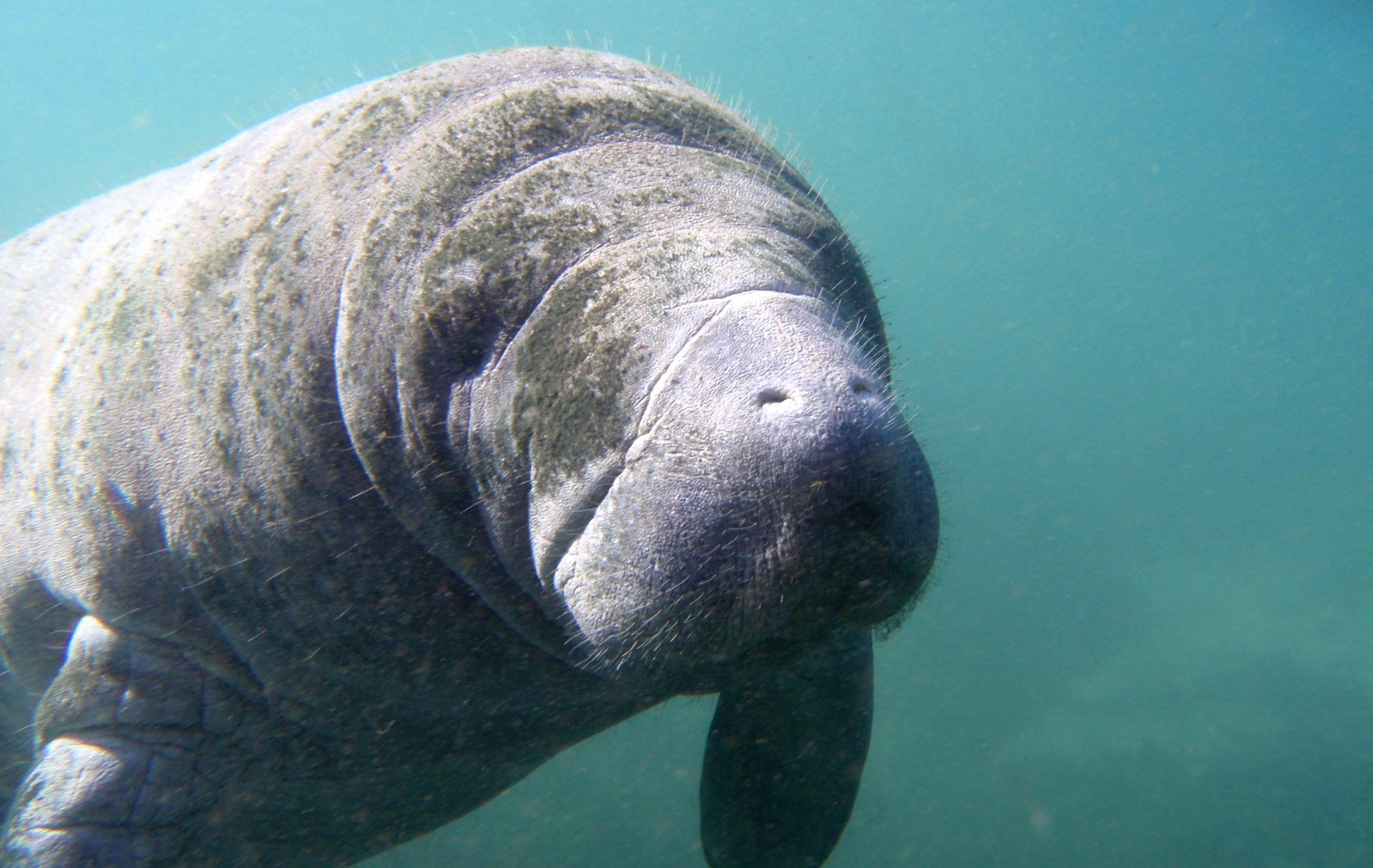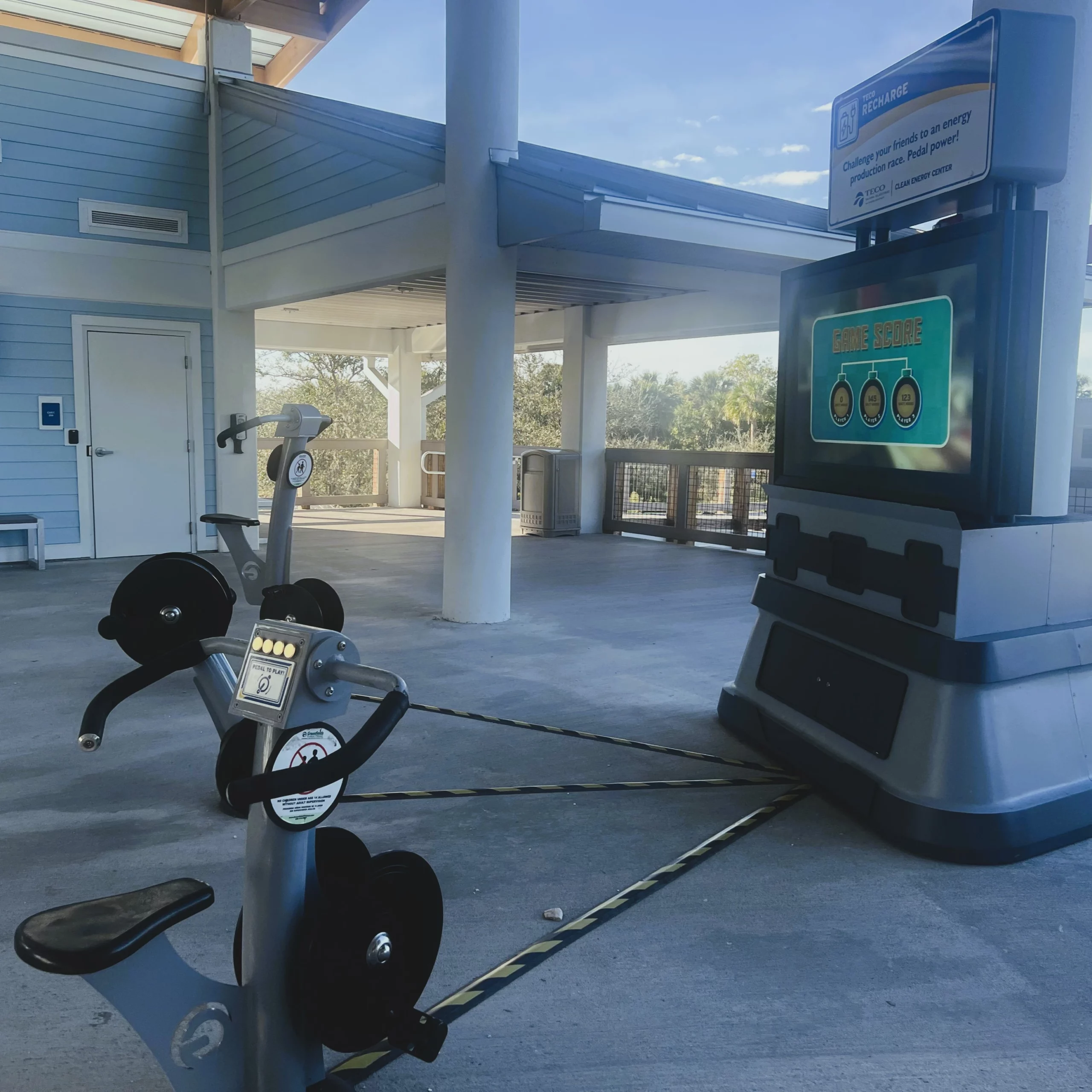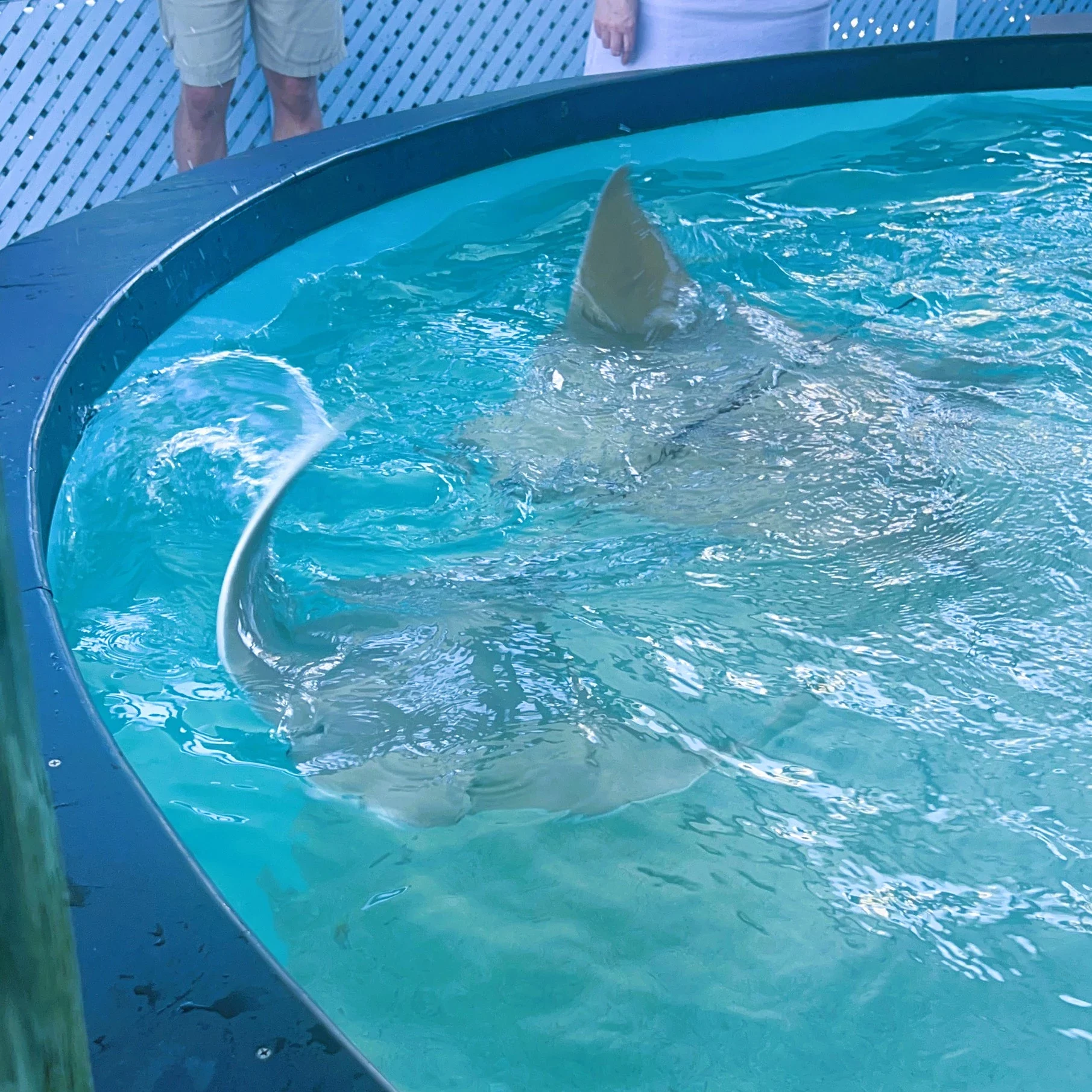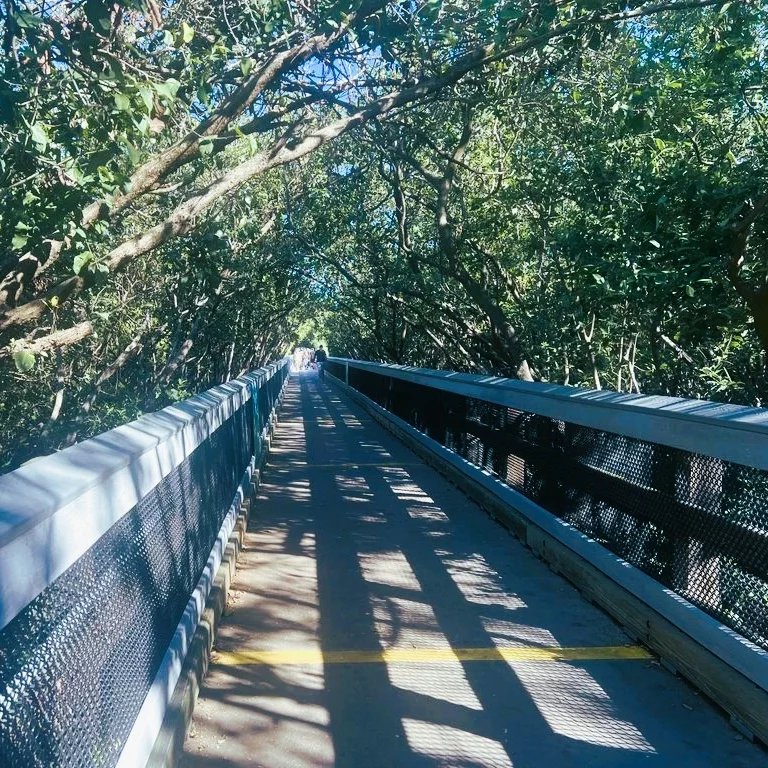‘Snouts up – the manatees are the star of the show’ at Tampa Electric’s Manatee Viewing Center.
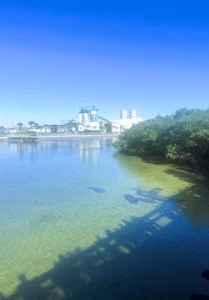 On a crisp winter afternoon, about 100 people line up along the railing on a wood-planked boardwalk that juts out over Tampa Bay Florida’s Big Bend power station’s clean, warm water discharge canal. Wearing sweatshirts and windbreakers, they peer below at the shallow, olive-green waters at what appear to be three dozen or so elongated shadows. The “shadows” are a subspecies of the West Indian manatee, the Florida manatee, who gently maneuver the warm waters just feet below the tidal walk.
On a crisp winter afternoon, about 100 people line up along the railing on a wood-planked boardwalk that juts out over Tampa Bay Florida’s Big Bend power station’s clean, warm water discharge canal. Wearing sweatshirts and windbreakers, they peer below at the shallow, olive-green waters at what appear to be three dozen or so elongated shadows. The “shadows” are a subspecies of the West Indian manatee, the Florida manatee, who gently maneuver the warm waters just feet below the tidal walk.
Some manatees rest motionless while others play, and still others bob to the surface for gulps of air before quickly making a series of half-moon swirls on the water’s surface before submerging to nestle in with the herd in the balmy waters of Tampa Electric’s Big Bend power plant.
The idyllic scene is an interesting juxtaposition: the hulking, industrial concrete coal-fired and natural gas power plant with two of its four stacks belching billowy white clouds of a combination of water vapor and carbon dioxide into a crystal blue cloudless sky form the backdrop to a seasonal sighting of oval-shaped manatees, which have inhabited Florida’s waterways for one million years.
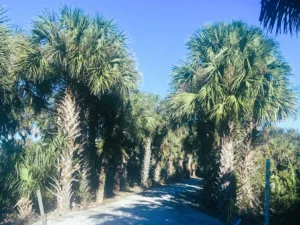 Just beneath the surface of the brackish water with thick meadows of seagrasses, including manatee grass, turtle grass, shoal grass, and widgeon grass, these graceful, gentle giants perform an underwater ballet of their humdrum daily winter routine: swimming, eating, and mostly resting and sleeping in these shallow sheltered waters.
Just beneath the surface of the brackish water with thick meadows of seagrasses, including manatee grass, turtle grass, shoal grass, and widgeon grass, these graceful, gentle giants perform an underwater ballet of their humdrum daily winter routine: swimming, eating, and mostly resting and sleeping in these shallow sheltered waters.
A power plant may seem like an unlikely wildlife attraction, but that is what visitors find at Tampa Electric’s Manatee Viewing Center, a protected marine reserve that attracts dozens of manatees who seek out the power plant’s warm-water outfalls in the winter months when local water temperatures drop below 68 degrees Fahrenheit. Here, in the discharge canal off Tampa Bay, manatees roam, seeking the soothing and life-sustaining warm waters in Apollo Beach, an area of former mangrove farms east of Tampa Bay.
 The largest of the world’s three types of manatees, these manatees were once endangered. The species is still threatened, and there are only about 13,000 in the wild, according to the U.S. Fish and Wildlife Service. Due to this precarious status, manatees are protected under the Endangered Species Act and the Marine Mammal Protection Act.
The largest of the world’s three types of manatees, these manatees were once endangered. The species is still threatened, and there are only about 13,000 in the wild, according to the U.S. Fish and Wildlife Service. Due to this precarious status, manatees are protected under the Endangered Species Act and the Marine Mammal Protection Act.
Approximately, 6,300 manatees swim in Florida’s shallow waters and beyond, but from roughly mid-November to the end of March, manatees congregate in Florida’s natural springs like Blue Spring State Park in Orange City, Crystal River National Wildlife Refuge in Crystal River, and Manatee Springs State Park in Chiefland, and power plant discharge basins like Tampa Electric’s Manatee Viewing Center. There are also manatees in captivity and rehabilitation at seven Florida aquariums and aquatic centers, including Miami Seaquarium, MOTE Marine Laboratory & Aquarium in Sarasota, Fla., and at SeaBase at EPCOT in Orlando, Fla.
At Tampa Electric’s Manatee Viewing Center, visitors walk along a 900-foot ADA-accessible walkway flanked by mangroves and, at the end, are afforded up-close views of manatees, which first roamed land — not water — 45 million years ago. The walkway is a stop on the Great Florida Birding Trail, a network of 500-plus wildlife viewing sites across Florida.
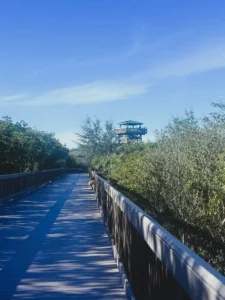 These “sea cows,” nicknamed such because they are herbivores and eat underwater vegetation like seagrasses and aquatic plants, may look fat, but they lack blubber. Therefore, they cannot survive for extended periods of time in water that is cooler than 68 degrees Fahrenheit, so they seek out warm waters from peninsular Florida’s natural springs and power plants. And according to an exhibit sign along the Manatee Viewing Center’s tidal walk, they can also eat up to 15 percent of their body weight in a day, which is about 150-pounds of plants for a 1,000-pound manatee,
These “sea cows,” nicknamed such because they are herbivores and eat underwater vegetation like seagrasses and aquatic plants, may look fat, but they lack blubber. Therefore, they cannot survive for extended periods of time in water that is cooler than 68 degrees Fahrenheit, so they seek out warm waters from peninsular Florida’s natural springs and power plants. And according to an exhibit sign along the Manatee Viewing Center’s tidal walk, they can also eat up to 15 percent of their body weight in a day, which is about 150-pounds of plants for a 1,000-pound manatee,
“Power plants such as Big Bend use bay water to cool equipment. The Big Bend power station circulates water from Tampa Bay for cooling, and then sends the water flowing clean and warm back into the bay, attracting manatees during the cooler months of the year,” said Lauren Goldsworthy Gomez, Environmental Specialist / Environmental Education at Tampa Electric – Environmental Services.
On a cool 55-degree December day, the crowd of families, retirees, and tourists lean on the boardwalk’s railing to snap photos and take videos of the finely wrinkled, grayish-brown manatees who can, from snout to paddle-shaped tail, measure up to 12 feet and weigh up to 1,200 pounds. A pair of manatees wave their small, pectoral flippers while another dozen or so glide about the estuary, where clean water flows. Manatees use their flippers to steer and hold vegetation while they eat.
 Suddenly, a rushing sound akin to a swimmer blowing water out of a snorkel breaks the hush of the crowd as a snout from a manatee pokes through the water’s surface, its nose flapping open and closed as the manatee fills its lungs before descending again into the water. A manatee may surface every seven to 20 minutes to breathe, according to a placard along the boardwalk.
Suddenly, a rushing sound akin to a swimmer blowing water out of a snorkel breaks the hush of the crowd as a snout from a manatee pokes through the water’s surface, its nose flapping open and closed as the manatee fills its lungs before descending again into the water. A manatee may surface every seven to 20 minutes to breathe, according to a placard along the boardwalk.
The majority of the manatees rest motionless in the shallow, clear waters, nearly oblivious to the striped mullet, redfin needlefish, blue tilapia, Atlantic tarpon, common snook, and stingrays that swim in the waters here. Admiring the mesmerizing spectacle in placid water with reflections of the power plant’s quartet of stacks makes for an unexpectedly tranquil afternoon in the Florida sunshine.
The Manatee Viewing Center opened in 1986 after manatees were seen aggregating in the canal during winter. Today, the state and federal sanctuary for manatees is part of the Florida Conservation & Technology Center, a 500-acre campus that is a collaboration among Tampa Electric, the Florida Aquarium, and the Florida Fish and Wildlife Conservation Commission.
The campus includes a stingray touch tank that is the off-season home of the actual mascots of Major League Baseball’s Tampa Bay Rays, an educational center, four coastal habitat walking trails ranging from just over three-quarters of a mile to just under two miles, a 50-foot-tall wildlife observation tower with views of Tampa Bay (on a clear day, you can see Tampa, which is 11 miles away), the Clean Energy Demonstration Center, an outdoor pavilion that has interactive games like geocaching and a cycling race to learn solar and wind energy can be harnessed and stored.
Brown pelicans, white ibis, great egrets, anhinga, osprey, and tricolored heron are just some of the birds that may be spotted along the tidal walk, nature trail, and waterway. Solar-powered picnic tables along the trails are perfect spots to charge mobile devices and recharge with picnic snacks while nature-watching.
Tampa Electric isn’t alone in turning a power plant into an eco-tourism hotspot while providing refuge to manatees, which remain at risk from red tide, cold stress, and human activity like boating. Another electric company, Florida Power & Light Company, opened its Manatee Lagoon – an FPL Eco-Discovery Center in West Palm Beach in 2016 after it modernized its natural gas plant there. The free attraction includes an observation deck for viewing manatees who swim in the outflows of FPL’s Riviera Beach Next Generation Clean Energy Center, and a 16,000-square-foot education center with exhibits on manatees and the Lake Worth Lagoon.
The best time to spot Florida manatees is from November to March, when there have been several days of cold weather. Manatee viewing centers, including Tampa Electric and FPL’s, have manatee cams online that you can consult before heading out to view these peaceful mammals. And truly, there’s nothing like spending a day viewing manatees at a powerful aquatic refuge.

